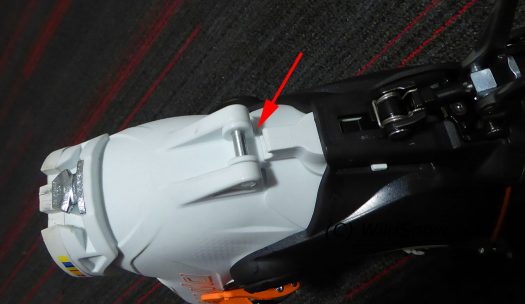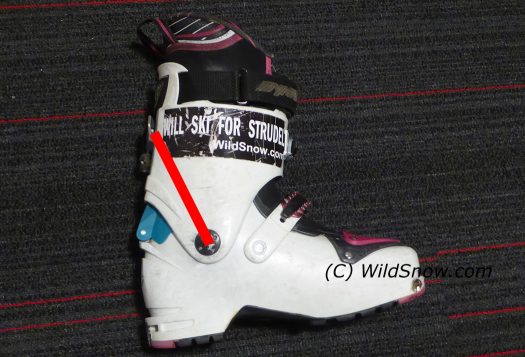The dreaded boot bulge is nearly ubiquitous to ski touring — ugly as the squeamish profile of an under-inflated tire and just as detrimental to performance. The problem is basic. In downhill mode you anchor the the boot’s upper cuff at one point with the lean lock, creating a triangle of force that tends to spread the cuff at the pivot points when you flex forward, this happening at the exact time in the ski turn you want the boot tighter, not looser.
Try to fix this with reinforcements, you might get less bulge but end up with little to no “progressive flex” (as well as increased weight). If “anti-bulge” stiffened reinforcements are taken to the limit, it feels like you’re skiing with steel bands on your legs. In the name of lighter weight “cabrillo” boot you get somewhat used to this sort of feel, “somewhat” being the operative word. Overlap type boot shells can mitigate the bulging syndrome as well, but introduce other problems for ski touring.
Hoji combines sweet flex with the lighter an easily entered cabrillo type shell. Despite our emphasis on the one-motion “pants down always” touring latch system, we are here to tell you it skis downhill quite well — and does NOT bulge in any fashion compared to conventional touring boots. The reasons for that are fairly simple, yet not entirely obvious at first glance. A few photos of what was explained to us by the boot’s eponymous master.

First key to the ‘Hoji Flex’ is not anchoring the cuff flex stop at lower rear. In the case of Hoji, as pictured here, the cuff stop only functions to block rearward travel, it allows forward cuff flex. This is key to feeling a sweeter progressive flex. Boots with cuff locks that anchor both directions give a more rigid and “blocked” feel for obvious reasons.

TLT 6, line of flex anchor resistance goes from single point down to cuff pivots, forming a triangle as viewed from rear.

Cuff force-resistance lines as viewed from rear. The Hoji lines are vertical, anchored at the top by right and left cuff stops. Not the first boot to have this,
difference with Hoji is how carefully this is designed and tuned to give the requisite flex without the boot folding up.

Hoji lines of resistance-force are vertical, right and left. You don’t get a bulge inducing triangle as viewed from rear.

Cuff stop in Hoji boot moves up and down, exists on both sides thus creating vertical lines of force-resistance when you flex the cuff. In turn, this does not tend to push bulge the cuff out at the pivot points. Hoji boasts a few other fine points in terms of tuning the flex, but what we’re describing here is the main difference between Hoji and most other cabrillo ski touring boots.
Downsides of this? Fairly complex to design and manufacture, with possibility of problems if the cuff flex stops don’t align. A bit heavier than some of the simpler systems out there. Can’t think of anything else.
All this can be observed during a carpet test. Have at it!
WildSnow.com publisher emeritus and founder Lou (Louis Dawson) has a 50+ years career in climbing, backcountry skiing and ski mountaineering. He was the first person in history to ski down all 54 Colorado 14,000-foot peaks, has authored numerous books about about backcountry skiing, and has skied from the summit of Denali in Alaska, North America’s highest mountain.

